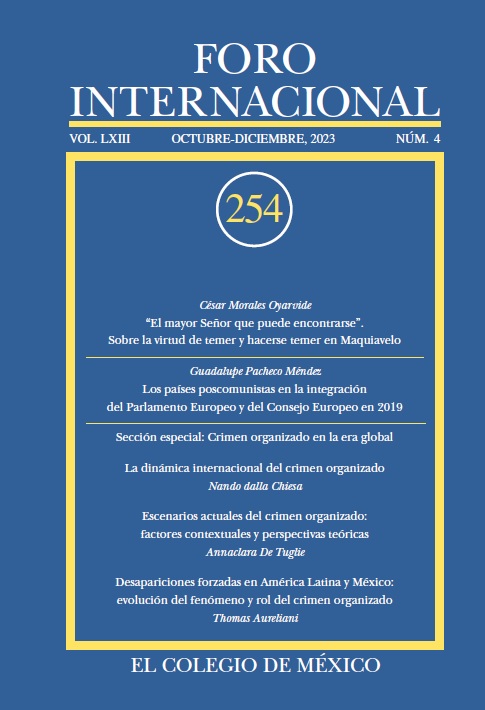Current scenarios of organized crime: contextual factors and theoretical perspectives
DOI:
https://doi.org/10.24201/fi.v63i4.3031Keywords:
organized crime, drug trafficking, mafia, money laundering, forced disappearance, extortion, Mexico, ItalyAbstract
The severe crisis of insecurity and human rights in contemporary Mexico demands from academia a profound analysis of the phenomenon of organized crime, informed by international experiences and sensitive to its dual nature as a phenomenon with deep local roots that is, simultaneously, inseparable from the flows of the global economy. Against this backdrop, in March 2023, the seminar “Dialogues from the Frontiers of Organized Crime: Organized Crime, Rights, and Educational Poverty” was held at El Colegio de México, in collaboration with the University of Milan, the Embassy of Italy in Mexico, the Pontifical International Marian Academy, the Mexican Institute for Justice, and the Memory and Tolerance Museum.
During the seminar, scholars, analysts, and officials examined the penetration of organized crime into the political, social, and economic life of Mexico and other Latin American countries, with special attention to the parallels and lessons that can be drawn from the Italian experience. In Italy, as in Mexico today, the historical intertwining of crime with economic and social relations has confronted the state, political elites, and civil society with the need to initiate extraordinary processes of memory, truth, justice, and institutional reconstruction.
Due to the significance of the topic and the introduction of analytical perspectives useful for studying criminal dynamics and its implications, we reproduce three presentations from the seminar. In the first, Nando dalla Chiesa, a prominent sociologist, intellectual, professor at the University of Milan, and emblematic figure of the Italian anti-mafia movement, outlines three approaches to the study of criminal dynamics at the international level. These approaches include the process of multiplication of criminal organizations on a global scale, the proliferation of mercenary armies and paramilitary forces, and the growing interconnection between crime and political terrorism. Dalla Chiesa also reflects on the difficulties in distinguishing criminal activity from the rest of economic and social interaction. Phenomena like money laundering increasingly blur the boundaries between society and crime, formal and informal economy, businesspeople and criminals, legality and illegality.
In the second presentation, Annaclara De Tuglie reflects on the levels of analysis in the study of organized crime, ranging from a “macro” perspective that addresses the geopolitical and transnational components of the phenomenon (such as migration, capital flows to tax havens, among others) to the “micro” level, which focuses on individual and local experiences in dealing with crime and the conditions that facilitate its reproduction. Finally, leveraging the analytical tools discussed in the other presentations, Thomas Aureliani provides an overview of the phenomenon of forced disappearances in Mexico, based on his own fieldwork and testimonies from family members of victims of a crime that starkly reflects the crisis of stateness and human rights overshadowing the country.
Downloads
References
ARENDT, Hannah, On Violence, Nueva York, HarperCollins Publishers, 1970.
Azul Originario, Centro de Estudios de la Diversidad Sexual y Genérica (AMATE), Cristosal, Fundación de Estudios para la Aplicación del Derecho (FESPAD), Instituto de Derechos Humanos de la UCA (Idhuca), Red Salvadoreña de Defensoras de Derechos Humanos, Servicio Social Pasionista (SSPAS), Informe anual sobre violaciones a derechos humanos durante el estado de excepción en El Salvador, San Salvador, 2023.
BOER, John de y Louise BOSETTI, The Crime — Conflict “Nexus”: State of the Evidence, United Nations University Centre for Policy Research, Occasional Paper 5, julio de 2015.
CATINO, Maurizio, “La mafia come fenomeno organizzativo”, Quaderni di Sociologia, núm. 14, 1997, pp. 83-98. DOI: https://doi.org/10.4000/qds.1533
CATINO, Maurizio, Le organizzazioni mafiose. La mano invisibile dell’impresa criminale, Bolonia, Il Mulino, 2020.
CHIESA, Nando dalla (ed.), Mafia globale. Le organizzazioni criminali del mondo, Italia, Laurana Editore, 2017.
CHIESA, Nando dalla, Manifesto dell’Antimafia, Turín, Giulio Einaudi Editore, 2014.
COLANTONI, Lorenzo, Giulia Sofia FARNO y Margherita BIANCHI, Fighting Environmental Crime in Europe. An Assessment of Trends, Players and Action, Roma, Istituto Affari Internazionali e AMBITUS, 2022.
CRUZ, José Miguel y Nelson Portillo PEÑA, Solidaridad y violencia en la pandillas del gran San Salvador. Más allá de la vida loca, El Salvador, UCA Editores, 1998.
DECKER, Scott H. y Barrik VAN WINKLE, Life in the Gang: Family, Friends, and Violence, Cambridge University Press, Cambridge, 1996. DOI: https://doi.org/10.1017/CBO9781139174732
DICKIE, John, Cosa nostra. Storia della mafia siciliana, Bari, Laterza, 2008.
DIEGO VIGIL, James, Multiple Marginality and Gangs: Through a Prison Darkly, New Jersey, Lexington Books, 2021. DOI: https://doi.org/10.5771/9781793613325
Financial Action Task Force, Money Loundering Vulnerabilities of Free Trade Zones, FATF Report, marzo de 2010.
Fondazione Giovanni Falcone (ed.), La Convenzione di Palermo. Il sogno di Falcone: l’alleanza degli Stati contro la criminalità organizzata transnazionale, Palermo, Glifo Edizioni, 2019.
FOOT WHYTE, William, Street Corner Society. The Social Structure of an Italian Slum, Chicago, University of Chicago Press, 1993. DOI: https://doi.org/10.7208/chicago/9780226922669.001.0001
FRENG, Adrienne y Finn-Aage ESBENSEN, “Race and Gang Affiliation: An Examination of Multiple Marginality”, Justice Quarterly, vol. 24, núm. 4 (2007), pp. 600-628. DOI: https://doi.org/10.1080/07418820701717136
GLENNY, Misha, McMafia. Droga, armi, esseri umani: viaggio attraverso il nuovo crimine organizzato globale, Milán, Mondadori, 2008.
GRAZIANO, Manlio, Geopolitica: orientarsi nel grande disordine internazionale, Bolonia, il Mulino, 2019.
HAZEN, Jennifer y Dennis RODGERS, Global Gangs: Street Violence across the World, Minneapolis, University of Minnesota Press, 2014. DOI: https://doi.org/10.5749/minnesota/9780816691470.001.0001
IMPICCIATORE, Roberto, “20 dicembre 1955: l’accordo per i lavoratori italiani in Germania”, Rivista il Mulino, 19 de diciembre de 2019, rivistailmulino.it
KALDOR, Mary, New and Old Wars: Organized Violence in a Global Era, Cambridge, Polity Press, 2012.
LOCKE, Rachel, Organized Crime, Conflict, and Fragility: A New Approach, Nueva York, International Peace Institute, julio de 2012.
LUPO, Salvatore, Quando la mafia trovò l’America. Storia di un intreccio intercontinentale, 1888-2008, Turín, Einaudi, 2008.
MAXSON, Cheryl L., Finn-Aage ESBENSEN, Gang Transitions and Transformations in an International Context, Cham, Springer International Publishing, 2016. DOI: https://doi.org/10.1007/978-3-319-29602-9
MIRAGLIA, Paula, Rolando OCHOA e Ivan BRISCOE, Transnational Organised Crime and Fragile States, OECD, International Center for the Prevention of Crime and the Clingendael Institute, octubre de 2012.
MUGGAH, Robert, “Organized Crime in Armed Conflicts and Other Situations of Violence”, International Review of the Red Cross, vol. 105, núm. 923, 2023, pp. 569-574. DOI: https://doi.org/10.1017/S1816383123000036
Naciones Unidas, United Nations Environment Programme, The rise of environmental crime: A growing threat to natural resources peace, development and security, UNEP, 2016, https://wedocs.unep.org/20.500.11822/7662
Oficina de las Naciones Unidas contra la Droga y el Delito (UNODC), Measuring Organised Crime in the Western Balkans, Viena, UNODC, 2020.
SABATINO, Michele, “Crime Treasure Islands: Tax Havens, Tax Evasion and Money Laundering”, Journal of Economics and Business, vol. 3, núm. 1, 2020. DOI: https://doi.org/10.31014/aior.1992.03.01.188
SINGA, J. P., ILO database on export processing zones (Revised), OIT, Working paper, 2007, http://www.ilo.org/public/libdoc/ilo/2007/107B09_80_engl.pdf
STRAZZARI, Francesco, Notte Balcanica, Guerre, crimine, stati falliti alle soglie d’Europa, Bolonia, il Mulino, 2008.
TRASHER, Frederic, The Gang: A study of 1,313 Gangs in Chicago, Chicago, University of Chicago Press, 1960.













